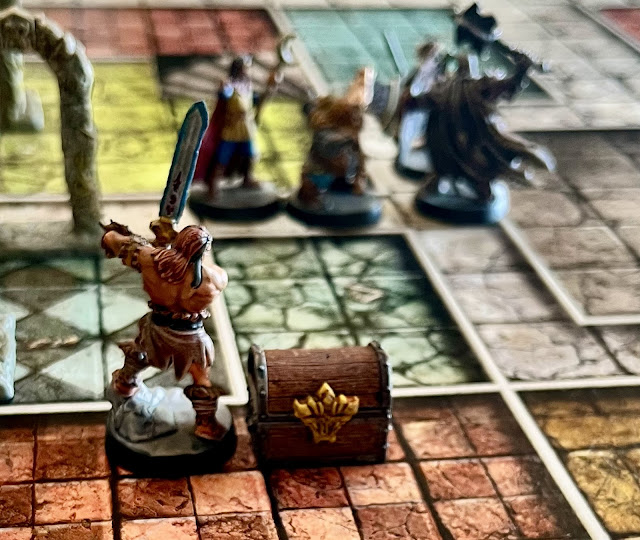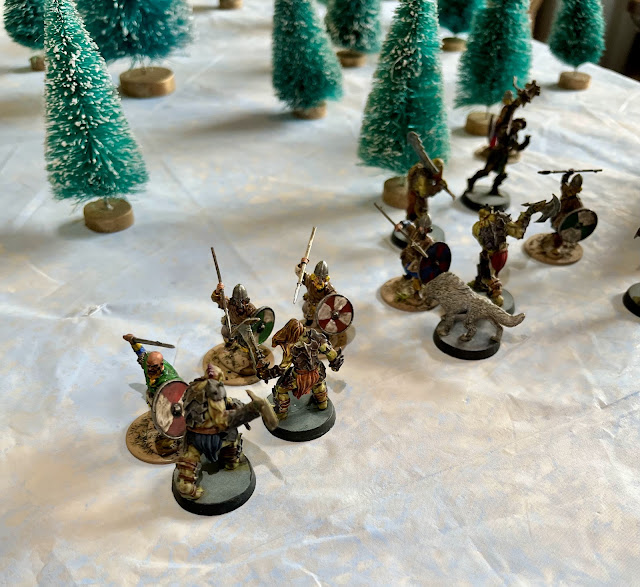One of my Goals for 2025 was to pick-up and paint a new Heroquest expansion. I was off to a good start when I picked up a copy of Mage in the Mirror which was an Elf focused expansion. It was a bit of a pre-lude to Rise of the Dread Moon as both took place in the Kingdom of the Heroquest Elves. However, Mage in the Mirror had been a re-print from the O.G. Heroquest, even though I think it was region locked as I do not recall seeing it in the US.
This expansion came with a new set of "elf" themed furniture, effectively doubling the amount of Heroquest furniture I had now. In addition, it came with some new enemies in the form of giant wolves, Ogres, and Elf warriors. There was also a special model for the villain and a new male Elf model. That meant there was a lot of stuff to paint! However, right off the bat I decided that I was not going to paint the enemy elves yet, because Rise of the Dread Moon also had some, and I figured it would be easier to paint them all at once. I learned from Kellar's Keep that it is not as easy to go back and match paint schemes later as you would hope.
So, with all that preamble out of the way, let's take a closer look at some painting huh? The hardest part of any painting project for me is getting started. Thankfully, I have a bit of a routine for getting minis ready to paint so I can fall back onto muscle memory for most of it. Like always, I undercoated them with GW's Grey Seer, gave them all a dark grey wash made from cheap acrylic paint from a Big-Box Retailer, and then drybrushed them with cheap acrylic white. They were undercoated and ready to paint. This undercoating method works really well with Speedpaints.
I decided to get started with the Giant Wolves first. I had previously painted a Heroquest wolf from the Against the Ogres box and wanted them to look a bit different from that dude. He was just a "regular" wolf and a potential Mercenary/Shape-shifted Druid. I also wanted them all to be a bit distinctive because I wanted to be able to tell which one was which during hectic games. Therefore, I decided to paint them all in different colors. I started by using Alchemy Purple on their little puppy tongues, Grim Black for their noses and eyes, and Pallid Bone for their teeth and claws. For some reason known only unto God, I decided to paint one Holy White, another Dark Wood brown, and the last one with a combination of Sand Golem and Hardened Leather. Then after Light Tone wash I finished them off with the standard Runic Grey base and Flat Black rim. Not sure I like them, BUT they are done and that's all that matters.
From there, I decided to tackle all the furniture. What is interesting about painting my ever-expanding line of Heroquest models is to try to keep them somewhat internally consistent. For example, I had been using Pallid Bone as a "metal" on the Elf's swords and armor. I also used a Plasma Bolt green for their runes and magic. Elsewhere, for plant roots and such I used Malignant Green. I also tend to use Runic Grey for stone, and Gravelord Grey for wrought iron looking metal. I wanted to make sure I stayed consistent with these approaches as I moved forward. Man, I should really write some of this down somewhere.... like a blog or something.....
Anyway, here is a WIP shot as I power through the furniture. For this batch I decide that all the wood would be Sand Golem, much lighter than the Hardened Leather and Dark Wood I used on my regular Heroquest furniture. However, that is also the skin-color I used for my Ogres when I painted them for Against the Ogres too.
A nice design touch is that the chests and doors are being held closed by plant vines and roots. That was an interesting design choice for the elven realms. The "hardest" part of painting these items was painting all the little details like books, bottles, boxes, scroll work, etc. I ended up using a lot of colors. The iron gates were also a challenge/chore to paint. They were chunky bois.
Here is all the new furniture done and dusted. I like how it turned out looking brighter and organic than the rest of my furniture. I even painted the bases for the mirrors so they would blend in better on the board.
That left the last minis I was planning on painting for this round, those pesky Ogres. These guys looked a bit less feral than the Ogres in Against the Ogres. In the supplement, they were using clubs and bone weapons. These dudes were clearly using metal axes. Last time I painted them, I decided that Ogres use Sand Golem skin. But I also decided that Absolution Green was a common Ogre hair color, as was Gravelord Grey. I knew I was going to have follow those design choices on these Ogres too. Finally, I also wanted to paint all their "kilts" different colors too. You know I like to be able to make them a bit unique on the board so I used Blood Red, Magic Blue, Fire Giant Orange, and Zealot Yellow.
The whole set took me about a month to get fully painted. Not too bad. However, I am starting to wonder if I might be running into a space limitation with all this Heroquest stuff? I will have to shuffle things around, but there is always room for one more! I think my next expansion will be Rise of the Dread Moon so I can finish off my Elf collection for Heroquest. Soon, I will have enough Heroquest models to make my own version of Battlemasters. :)
Until next time!








































